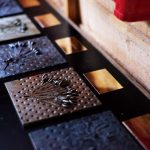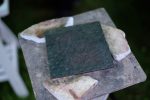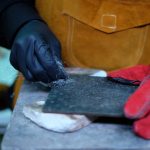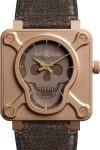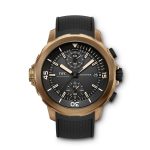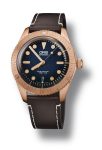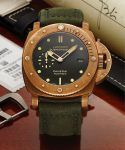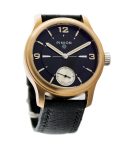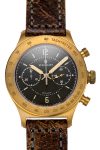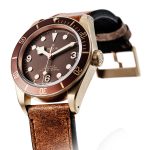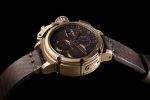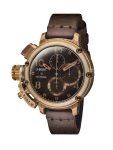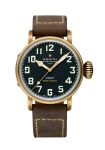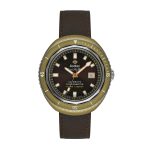Reviews
Bronze Stars
The watch world likes to elevate itself above the fickleness of fashion, seeing watches as a serious mechanical-based industry far removed from whim and mass-market demands. But you only need to look at the clusters that emerge year after year to know that this is more than a touch of false virtue. One brand announces that yellow, rose or white gold is the future, that blue dials or smaller diameters are de rigeur, or that minute repeaters are the complication du jour, and you can bet your bottom dollar that within months a whole bunch of watches following the same theme will emerge. So – although not the first to use the material in a modern case – when Panerai launched the limited edition Bronzo to huge international acclaim in 2012, it was only a matter of time before other brands followed suit.
Despite its use throughout history in cases of marine chronometers, bronze is not the most obvious choice for a wristwatch. A soft metal that changes colour and damages easily, what it does offer is the watch lover’s holy grail: uniqueness. By doing nothing more than wearing it, every bronze watch will develop a patina ranging in appearance from gold to black and even orange, pink, green or blue. And best of all, the base metal is protected by this coating, so if an owner finds the patina distasteful, they can polish it back to its original state – giving future Antiques Roadshow experts palpitations in the process.
There has also been a tension over the centuries between fine-art casting and war. In times of peace the cannon and arms have historically been melted down to make fine art, and in times of war the artworks were melted down to make the cannon and the arms. The metal developed during that time is a blend of copper, tin and zinc. Known as “gunmetal”, it casts and machines well and is resistant to corrosion, but it is by no means the only version of bronze.
An alloy traditionally composed of copper and tin in varying proportions, some modern bronzes contain no tin at all, substituting other metals such as aluminum, manganese or zinc. The results of alloying the copper are various: where there is a high tin content there is a greater sonorous quality, leading it to be labelled “bell metal”; the addition of phosphorus, manganese or zinc increases the strength rendering it good for use in mechanical engineering; and adding aluminum – as with many watch cases – leads to a strong and corrosion-resistant metal.
The all-important “patination” – little more than a more attractive word for “tarnish” – refers to the colouring of the metal surface caused by oxidisation. Oxides are created during the chemical reaction, resulting in the appearance of various colours on the metal. Patination is unique because the bronze changes colour according to the chemicals an individual comes across in their daily life, as well as the skin’s acidity and the individual levels of bacteria and microbes on a person’s skin.
The images opposite show an experiment hosted by Tudor in collaboration with bio-artist Sarah Craske and artist Stephen Melton, co-founders of Meltdowns Foundry in Ramsgate – a bronze fine art production company. Using the Tudor Black Bay Bronze alloy of copper, aluminium and silicon, Melton cast unique tiles of bronze bearing the Tudor logo and patterns created through a mix of seaweed and the calf leather used in the straps of the Black Bay Bronze. Although it usually takes months for patina to develop, Melton, Craske and their team demonstrated the process by painting on chemicals and artificially ageing the tiles with a blowtorch, effectively showing the process in fast-forward.
The result of the experiment was 20 very different artworks demonstrating just how unpredictable the changes in each bronze watchcase will be and, for this reason alone, the alloy is sure to be a staple in watchmaking for years to come. Below, Ken Kessler looks at some of the New Bronze Age pioneers already storming ahead in the patina stakes.
ARTYA SON OF A GUN BICOLOR BRONZE ON STEEL
As a company known for outré watches, ArtyA is a natural for using bronze – especially for its range of shootin’ iron-related models. No doubt, they were thinking of Remington’s Bronze Point bullets when the company created the Son of a Gun Bicolor Bronze On Steel. As with all models in the Sons of a Gun range (and I’m assuming that’s the correct plural), the watch stands out from the crowd because it contains actual, small- calibre bullets arranged around the central hub.
This particular version is a one-off model with a full nomenclature of “GUN24 – Bicolor Bronze On Steel 1/1 A0019 (Don’t Shout 1)”. It features an automatic movement – hours- and-minutes-only – with a power reserve of 42 hours. The oscillating mass that winds the watch is “ballasted with three real .357 Magnum bullet-bases” that are visible through the glass case back (Dirty Harry’s .44 Magnum shells are probably too large), while the half-dozen tiny bullets encircling the dial are genuine 6mm Flobert bullets. ArtyA assures us that the Flobert bullets have been previously shot “to avoid any troubles”.
Even though Flobert bullets and the related firearms are classified in most countries with air rifles, .22s and other small sporting guns, given the current heightened state of global paranoia, this is probably not a watch to wear when passing through security at most airports.
BELL & ROSS BR 01 SKULL BRONZE
This works so well that even those bored to tears with skull motifs have to acknowledge its undeniable cool: Bell & Ross has taken its most famous form, the round-dial-in-a-square-case BR 01 and fitted it with a skull-shaped dial and bezel. It’s pure Jolly Rogering, so to speak, culminating in a fabulous one-off for Only Watch 2015 with tourbillon and distressed case.
In its standard, unweathered bronze form, the Skull Bronze is based on the 46mm edition of the BR 01. Bell & Ross stayed faithful to the primarily aviation-related nature of the BR 01 because the skull motif has nothing to do with piracy per se. The company opted for the image to pay homage to various companies of parachutists in the Second World War.
BR 01 Skull Bronze fashions a raised skull and crossbones with a bezel that stands proud of the case, while the crossed bones terminate in the four points where the screws secure the case sections. Whatever century you prefer to address, and whether your interests include aviation or swashbuckling, the watch cannot help but to evoke the buccaneering spirit. This carries through to the cleverly designed hours-and-minutes hands, which are formed in the shapes of a dagger and a sabre. All that’s missing is a parrot. Or a hook. Or Johnny Depp’s signature on the back.
HUBLOT BIG BANG BULLET BANG
What’s with the bullet fetishism? Isn’t bronze enough? Ah, it’s just a name in this case, and the idea of “bang” has always suggested rearms with this range – either that, or the dawn of creation. For the now-familiar Big Bang chronographs, bronze may seem just another colour scheme, but, WOW, does it work! The bronze-look case contrasts perfectly with the black dial and strap, creating a combination to rival what seems to be the range’s default model, in rose gold and black. Not that the latter colour scheme is anything other than stunning. But rose gold simply won’t age with a unique patina like bronze.
Hmmm… that may also apply to Hublot’s bronze because it’s not the same as straight bronze as used by other makers in this round-up. For the Big Bang, the company used a scratch- resistant alloy called Cermet, which is a mix of ceramic, tungsten and a touch of bronze for the colour. Completing the look is a matte-black dial with raised, applied numerals and indices in a bronze colour, as are the skeletal hands. Limited to 500 pieces long since sold out, the Big Bang Bullet Bang has auction-only or vintage-specialist-only availability. And I’ve just found a tempting one online, complete with box and papers, at £15,000 – and another at £13,000.
IWC AQUATIMER CHRONOGRAPH EDITION “EXPEDITION CHARLES DARWIN”
Not all bronze watches aspire to a deliberately unfinished, steampunky roughness, that outdoorsy look which suggests grey, dented Land Rovers without carpets or Vibram-soled boots. Some, it turns out, are so elegant that one wonders how the patination will look. IWC’s latest 44mm offering in its support of research in the Galapagos Islands is one of them, as dressy a tool watch as one can imagine, but equally it is a timepiece reminiscent of the formal look of 1940s and 1950s chronographs from the likes of Gallet and Eberhard. This watch screams “Cary Grant” and “David Niven”.
Despite 30-bar water-resistance and chronograph functionality, IWC’s ref. 3795 with automatic chronograph Calibre 89365 is styled like something intended for wear with black tie rather than wetsuit. It features only two sub-dials, one for 60 minutes and one for 60 seconds, for an uncluttered appearance and 68-hour power reserve. Even the date is particularly discreet, in a small window at 3 o’clock. Again, the pairing of black and bronze is, as with the rest in this roundup, as immediately appealing as rose gold and black.
As all bronze watches feature non-bronze casebacks, because of the chemical interaction with the skin, this one is fitted with a steel back, too. But IWC added a wonderful detail: it’s engraved with a portrait of Charles Darwin. And I’m doing my best not to connect it to Big Bang theory.
ORIS CARL BRASHEAR LIMITED EDITION
Something in my bones tells me that this watch is, 2000- only limited edition status notwithstanding, the go-to model for those who want to own a timepiece in bronze without breaking the bank. Sure, the Tudor is higher pro file, and Panerai’s bronze models did more than most to popularise the genre, but Oris’s offering is based on one of the prettiest of all the revived 1960s classics, and the price isn’t offensive. Its base is, of course, the Divers Sixty- Five, one of the most amazing success stories of the past five years, and the sire of a new family in the Oris catalogue.
Everyone who saw the Divers Sixty-Five at its launch seemed to fall for it, so this modern classic seemed the natural choice when Oris wanted to produce something special to commemorate the life of Carl Brashear, the U.S. Navy’s first African American master diver. Instead of simply engraving some legend on a standard model, Oris issued an all-bronze version, with the dial details altered, too: for the Brashear edition, the dial is dark blue, the date on this version is positioned at 6 o’clock, rather than 3 o’clock as on the regular model, and the marker at 12 o’clock is an elongated triangle instead of a small shield shape. Also fitted is a rotating bezel in bronze, rather than white-on-black.
PANERAI LUMINOR SUBMERSIBLE 3 DAYS POWER RESERVE AUTOMATIC BRONZO
Cynics might say that the weathered and distressed look, taken to its ultimate forms by U-Boat’s Unicum and the various Romain Jerome Titanic DNA and Steampunk models, might be a design conceit too far, but then we live in a world where gullible idiots pay a fortune for defective dials, euphemistically called “tropicals”. At least U-Boat’s and Romain Jerome’s creations are deliberately so – as is the Panerai Bronzo, though you must await the patination. With the Panerai, the brutal look is inherent regardless of the materials.
Panerai’s use of bronze is made legitimate not by any applied wear-and-tear, nor even the anticipated ageing, but because of the nautical applications of the material, while the choice of a particularly chunky rotating bezel amplifies the effect: the Submersible 3 Days Automatic Bronzo enjoys the look of the Egiziano, but in a wearable size. This is the Panerai family with a massive expanse around the dial thanks to that distinctive rotating ring to indicate dive times, while the model also enjoys the trademark flip-lock crown depressor, securing it against moisture to 30 bar. A dark green dial complements the bronze of the case.
Inside the Luminor 1950 case is the in-house Calibre P9002, which also provides date and power reserve indication, the three-day duration attributed to twin barrels. The bronze merely adds to the frisson of adventure one associates with all Panerais.
PINION PURE BRONZE LE
But what if you’d like to buy British? And you just happen to be inspired by the saga of the evergreen Unitas 6498 movement? Is it possible to have both, and not break the bank? Yes, indeed, it is: the good folks at Pinion have a few bronze models in their line-up, and while Axis II Bronze has sold out, the versions in the Pure range are still available.
In addition to the similarly styled automatic Pure Pro Bronze, Pinion produces the 42mm Pure Bronze LE seen here, limited to 50 examples. This handsome hand-wound timepiece contains the aforementioned 6498, protected by a black dial with silvered sub-dial at 6 o’clock and big, bronze-coloured 3/9/12 hour markers and a black leather strap. The watch is water-resistant to 100m, and should develop a fetching patina after a few swims.
Like most Unitas-driven watches, the Power reserve is 45 hours, and Pinion points out that this watch has the added charm of a slower ticking sound, as you’d only find in a manually wound watch based on a pocket watch calibre. The price for this gorgeousness, girth and exclusivity? A reasonable £2,950.
By the way: if you’d like to keep your bronze watch pristine rather than sporting a patina, Pinion has an online guide on how to clean it: www.pinionwatches.com/cleaning- a-bronze-watch/
STEINHART MARINE OFFICER BRONZE
An accidental find, this, something I came across while doing my research: it’s so handsome and so embarrassingly under-priced at €910 plus shipping that it qualifies as a bargain. That’s because it is sold directly – as are Doxas, so please, no kvetching.
A so-called “homage” watch, in a form similar to the Panerai Mare Nostrum, it is one of a range of four in the same case. It is a dandy surrogate because – size and details aside, in cannot be mistaken for the real thing, even if you buy the one with a blue dial in a steel case, rather than the bronze. I placed it next to a genuine Mare Nostrum and the dimensions, pusher and other details were identical, save for the dial font.
As this is not pretending to be something else – the dial is very clear that this watch is a Steinhart –there are no guilt trips. Inside is a Dubois Dépraz DD 2030-equipped ETA 2824-2 movement, visible through the back, so there is another area to prevent confusion: the actual Mare Nostrum had a solid metal caseback.
For the bronze version, the dial is a dark green (like the Panerai Bronzo’s dial) and the strap is one of the best “distressed” leather types I’ve seen. Great looking watch, perfect size, legitimate, high-quality movement. At the price, then, a bronze bargain.
TUDOR HERITAGE BLACK BAY BRONZE
No contest: even with competition from Oris and Panerai in the ultra-coolness stakes, the latest variant on the hugely successful Black Bay is going to be a hit of monumental proportion. When you start with a watch as handsome as the Black Bay (and the fans of Blue, Burgundy and Black are evenly numbered), you can’t lose. Tudor, like many others, realised that the cocoa-coloured dial is the ideal match, while the equally milk-chocolatey bezel will evoke references to a certain sibling called the “Root Beer” – and that’s a good thing, Messrs. Rolex.
All else is familiar save for the straps, which arrive in both fabric and aged leather. The case itself is an aluminium/bronze alloy, a healthy 43mm in diameter and water resistant to 200m. Inside is Tudor’s new manufacture movement, the Calibre MT5601 with a generous 70-hour power reserve, and the historical veritism extends to “snowflake” hands.
There’s only one problem with Tudor’s Black Bay range: which to buy, as all six (if you include the Dark and 36mm) are achingly desirable. As one close friend already has two of them, with a third on the way, I think there’s only the one solution: buy the lot. But if that’s too much, suffice it to say, the Bronze will develop a cult of its own.
U-BOAT CHIMERA BRONZE 43
Preceded by the now collectable 47mm version, U-Boat’s Chimera Bronze 43 drops the size to a still-imposing 43mm – but then U-Boat doesn’t do watches for wallflowers. There’s a lot of metal here in spite of the downsizing, the watch fashioned in the usual U-boat manner of lots of seemingly inexplicable hardware to rival, say, Graham’s Chronofighters. This is the watch that Captain Nemo would buy if he didn’t want a Romain Jerome Titanic DNA. This is the kind of watch aimed at guys like me, who can’t stop playing with the damned things.
As is also U-Boat’s wont, the Chimera has the crown on the left- hand side, protected by a massive cover on a pivoting attachment. This reversal places the date aperture at 9 o’clock, so it’s basically a reversal of the 7750-style 6-9-12 sub-dial positioning to 12- 3-6. U-Boat opted for a popular dial colour, too, the chocolate brown perfectly complementing the bronze, while the antiqued brown strap completes the “tool watch” look.
Indeed, it’s so “period Italian” that it might cause you to acquire a taste for Toto lms, and I can’t wait to see how it patinates, with all its nooks and crannies to trap the oxidised deposits. This thing screams “hipster”, though my betters tell me that hipsters prefer Apple Watches.
ZENITH PILOT TYPE 20 EXTRA SPECIAL
If bronze watches are inherently vintage-looking, simply because the material evokes 19th-century metal-mongery, then a suitably- styled piece like this generously sized hunk of alloy embodies the spirit of the genre. It’s an onion-crowned, time-only model with cathedral hands and a font that looks like it was lifted off a saloon clock in Deadwood. Irrespective of the innate and chronologically correct 20th century-ness of aviation, Zenith’s Pilot Type 20 Extra Special in bronze still looks like it belongs to the period prior to the Wright Brothers’ exploits, rather than post.
At 45mm in diameter, the watch sends out another signal that suggests an earlier era: it resembles one of those early wristwatches that were made by converting pocket watches. But that element and the design memes listed above are purely aesthetic, serving to disguise an otherwise modern take on the outsized wristwatch. Inside is the Elite 679 automatic with 50-hour power reserve, beating at 4Hz. The crown screws down to ensure water resistance to 10ATM, and the massive bronze case is fitted with a titanium back, engraved with Zenith’s ying instruments logo.
Black dial, oversized numbers in Super-LumiNova SLN C3, contrasting gold-plated hands, the perfectly apt “Oily Nubuck” leather strap with protective rubber lining: Zenith’s bronze version makes an already noticeable timepiece simply unforgettable.
ZODIAC SUPER SEA WOLF 68 BRONZE
Enthusiasts with long memories will recall the Zodiac Sea Wolf of a half-century ago, a period when the company was a serious contender for diving watches; they even provided models for the military. The brand has, however, been playing it low key for decades, so you can imagine the delight imparted by the return of this watch, especially a sexy version in bronze.
Reminiscent of the highly collectable Seiko “tuna cans” (now there’s a candidate for bronzing), the new Super Sea Wolf 68 Bronze hides its lugs, so what you see is an uninterrupted oval with dimensions of 50x44mm and a case thickness of 17mm: this is a seriously butch watch. The black dial offsets the bronze case and unidirectional rotating bezel, while a further sense of depth is added by a raised chapter ring and large indices.
Zodiac has fitted an anti-reflective coated sapphire crystal, and the screw-down crown adds to water resistance rated at an impressive 1,000m. The massive bronze case protects a COSC Chronometer-rated automatic calibre STP1-11. The supplied strap is brown leather with a signed deployant buckle, while an olive green nylon strap is also an option. Priced at $2,095, it is one of the more affordable models in this round-up, making the Sea Wolf 68 a real bargain bronze watch.





